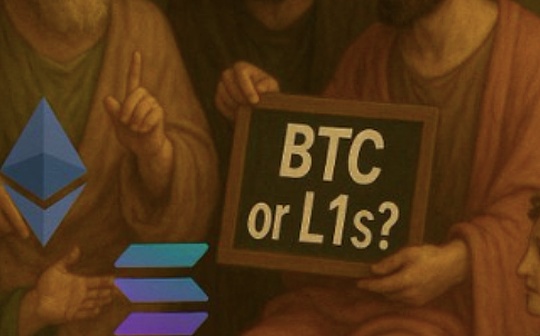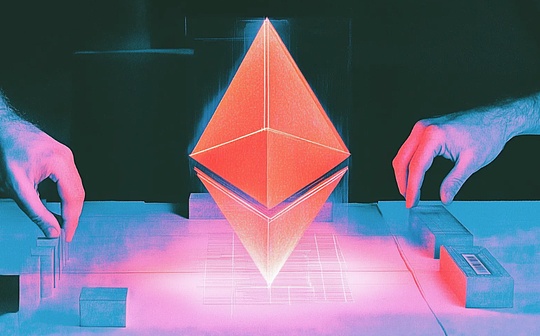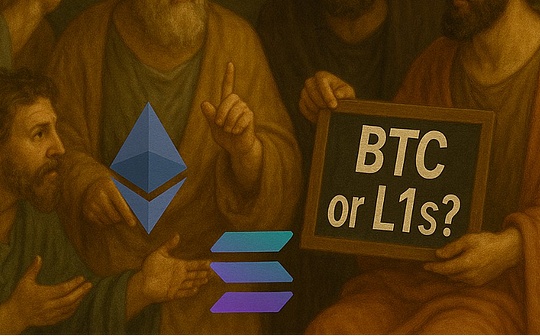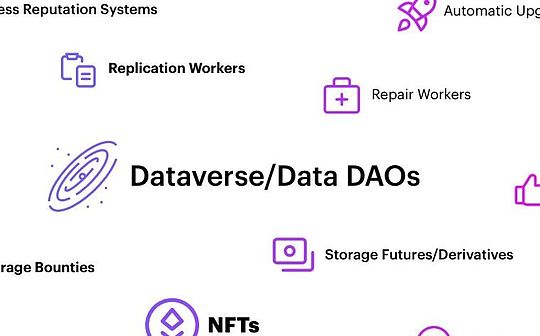
summary
-
Decentralized storage refers to a single entity or part of the group using its idle storage space as a unit of the storage network, so as to bypass the absolute control of data such as centralized agencies such as AWS and Google Cloud.
-
Low -storage costs, data redundant backup and Token economy are also decentralized storage. A large number of Web3 applications are based on this infrastructure.
-
As of June 2023, the overall storage capacity of decentralized storage has exceeded 22,000 PB (PB), while the network utilization rate is only about 20%.This shows that there will be a lot of room for growth in the future.
-
Among the existing storage capacity, about 80% of the storage capacity is provided by Filecoin, which is undoubtedly the leader in the field.Filecoin also launched projects such as Filecoin Plus and FVM to motivate developers and promote the development of ecosystems.
-
With the rise of artificial intelligence and full -chain games, decentralized computing and storage tracks are expected to usher in exciting growth opportunities.
>
Cloud storage services like Dropbox and Google Cloud have changed our way to store and share large files (such as videos and photos) online.They allow anyone to store a few TB data at a much lower cost than buying a new hard disk and access files from any device when needed.
However, there is a problem: users must rely on centralized entity management systems. These entities may cancel their access permissions at any time, share their documents with government agencies, and even delete files without reason.
This storage model has caused the ownership of data assets to be unclear, and in fact, large Internet companies such as Amazon and Google have monopolized data.In addition, the stop time of centralized services often brings catastrophic consequences.
The storage field is actually suitable for decentralized applications.First, it solves the problem of user data privacy and ownership.Documents stored on decentralized file services are not affected by any centralized agencies, such as government agencies that may want to control and review content.It can also prevent private companies from adopting incidents such as reviewing services or sharing documents with law enforcement agencies.
Secondly, a large amount of data is stored in the index itself, and a distributed system is required.Existing centralized cloud services also use distributed schemes, such as Spanner, TIDB, etc.It can be said that distribution does not mean centralization, but decentralization must be distributed.Different from the architecture of centralized storage, the existing decentralization scheme will divide the data into small pieces and store it on various nodes around the world after encryption.Essence
>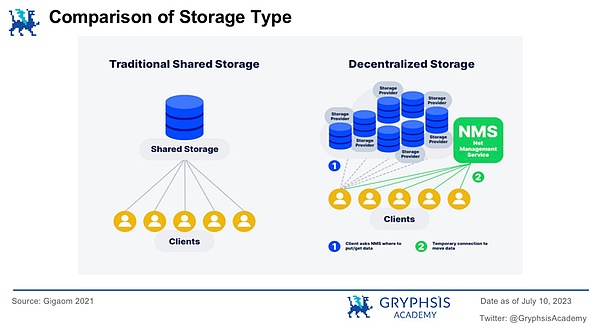
Third, the resource consumption of invalid mining is solved.A large amount of electric energy consumption caused by Bitcoin’s POW mechanism has always been criticized, and decentralized storage has given users an opportunity to become nodes. It can be mining and profitable through idle storage resources.A large amount of storage nodes also means a reduction in costs. It is foreseeable that decentralized storage cloud services can even eat a part of the market share of the web2 cloud service.
Today, with the continuous upgrading of network bandwidth and hardware services, this is a huge market. According to Business Research, the global database market will exceed $ 120 billion in 2028.
>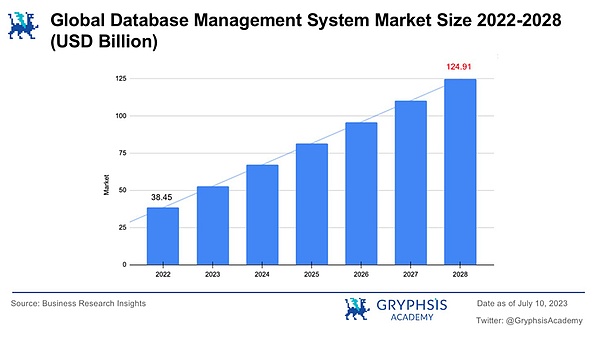
>
In order to create a truly decentralized application, the decentralized database should also be included in the web3 application architecture.It can be divided into four main components: smart contract layers, file storage, databases and general infrastructure layers.
The smart contract layer is equivalent to Layer1, while the general infrastructure layer includes but not limited to the prophet, RPC, access control, identity, under -chain computing and indexing network.
>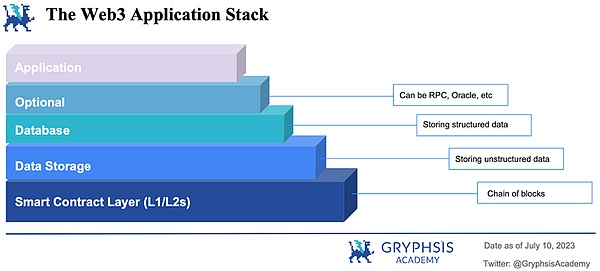
Although the user perception is not obvious, the file storage and the database layer play a vital role in the development of Web3 applications.They provide the necessary infrastructure for storage structured and non -structured data, which are the requirements of various applications.Due to the nature of this report, these two components will be further introduced below.
>
DFSNS such as Filecoin, Arweave, and Crust are mainly used for the lasting storage of non -structural data. These data do not follow the predefined format, nor do they need to be updated or retrieved frequently.Therefore, DFSNS is usually used to store various static types of data, such as text documents, images, audio files and videos.
One of the advantages of this type of data in distributed storage architecture is that it can use edge storage device or edge data centers to move data storage closer to the terminal.This storage method provides lower network communication costs, lower interaction delays and lower bandwidth expenses.It also provides greater adaptability and scalability.
For example, taking StorJ as an example, the monthly storage cost of 1TB is $ 4.00, while the market leader’s corporate cloud storage solution Amazon S3 is charged about $ 23.00 a month on the same amount of data.
Compared with the traditional centralized cloud storage solution, users can benefit from more cost -effective storage options.DFSNS’s decentralization characteristics also provide higher data security, privacy, and controlling, because data is distributed between multiple nodes or miners, rather than stored in a single centralized server.
>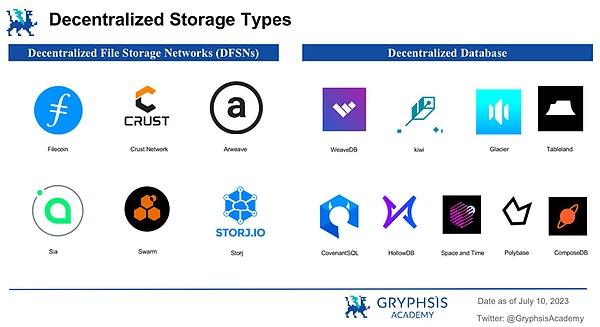
>
The limitations of non -structured files in DFSNS are obvious, especially in high efficient data retrieval and update.For data that needs to be updated frequently, these architectures are not the most ideal choice.
In this case, traditional databases such as MySQL and Redis are more suitable for developers. They have been widely optimized and tested in the Internet era of Web2.0.
Especially in applications such as blockchain games and social networks, storage structured data is an inevitable requirement.The traditional database provides a effective way to manage a large amount of dynamic data and control its access.They provide functions such as indexing, query, and data operation, which are essential for applications that depend on structured data.
Therefore, whether it is based on DFSNS or self -developed underlying storage.High -performance, high -availability decentralized database is a very important branch in the storage field.
>
>
In the current Web3 project, decentralized file storage items (DFSNS) can be roughly divided into two categories.The first category includes IPFS -based projects such as Filecoin and Crust.The second category includes AR, SIA, and Storj, which have their own underlying protocols or storage systems.Although they have different implementation methods, they all face the same challenges:Ensure that the truly decentralized storage is achieved while achieving efficient data storage and retrieval.
Because the blockchain itself is not suitable for storing a large amount of data on the chain, the relevant cost and the impact on the block space make this method unrealistic.Therefore, the ideal decentralized storage network must be able to store, retrieve and maintain data, and at the same time ensure that all participants in the network are inspired and complied with the trust mechanism of decentralized systems.
We will evaluate the technical characteristics and advantages and disadvantages of several mainstream projects from the following aspects:
>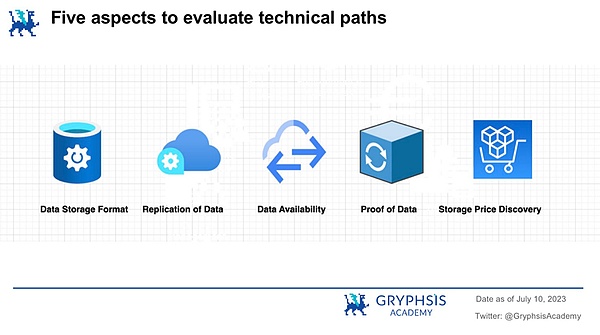
-
Data storage format:The storage protocol layer needs to determine how the data should be stored, such as whether the data should be encrypted, and the data should be used as a overall storage or a small distribution block.
-
Data replication backup: You need to decide where the data is stored. For example, how many nodes should be stored, whether all data should be copied to all nodes, or whether each node should receive different fragments to further protect the privacy of data.Data storage format and communication will determine the probability of data availability on the network, that is, the durability of the device when it fails with time.
-
Long -term data usability:The network needs to ensure that the data should be available.This means that the incentive mechanism is designed to prevent the storage node from deleting old data over time.
-
Proof of storage data:The network not only needs to know the storage location of the data, but also the storage node should prove that they really store the data they want to store to determine the share of the incentive.
-
Storage price discovery:The node is expected to pay for the continuous storage of the file.
>
>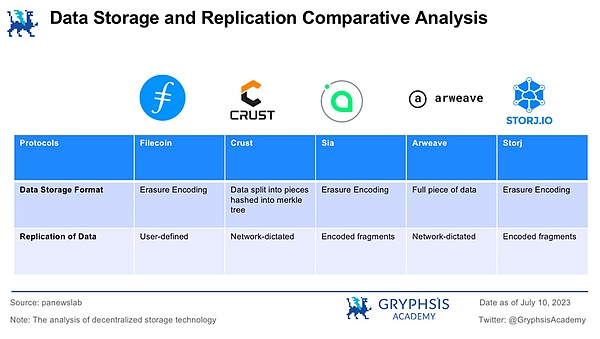
As mentioned just now, Filecoin and Crust use IPFS as a network protocol and communication layer to transmit files between equal points and store them on the node.
The difference is that Filecoin uses erase encoding (EC) to achieve scalability of data storage.Elimination encoding (EC) is a data protection method that divides data into fragments, extend and encodes redundant data blocks, and stores it in different locations, such as disks, storage nodes or other geographical locations.
EC creates a mathematical function to describe a set of numbers that allow the accuracy of them and restore them when one of the numbers is lost.
>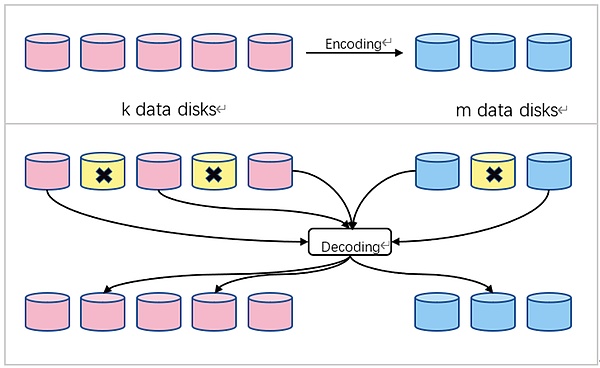
Source: usenix
The basic equation is n = k+m, where the total data block is equal to the original data block plus the school inspection block.
Calculate the M school block from the kitic data block.Stop this K+M data block on the K+M hard disk, respectively, you can tolerate any M hard disk failure.When a hard disk failure occurs, you can calculate all the original data blocks as long as you choose the K surviving data block.In the same way, if the K+M data block is scattered on different storage nodes, you can tolerate the M node failure.
When the new data is stored on the Filecoin network, the user must connect to a storage supplier through the Filecoin storage market, and negotiate the storage clause, and then the next storage orderEssenceAt the same time, users must decide which type of cornerstone code and copying factors in them.Through the deletion code, the data is decomposed into a constant -size fragment, each segment is extended, and the redundant data is encoded. Therefore, only a subset of the clip needs to be rebuilt the original file.Copy the factors refer to more storage sectors that should be copied to the storage miners.Once the miners and users are concluded, the data will be transmitted to the storage miners and stored in the storage sector of the storage miners.
Crust’s data storage method is different,When they copy the data to a fixed number of nodes: When the storage order is submitted, the data is encrypted and sent to at least 20 Crust IPFS nodes (the number of nodes can be adjusted).On each node, the data is divided into many smaller fragments, and these fragments are scattered into Merkle trees.Each node retains all fragments that constitute a complete file.
Arweave also uses the complete file copy,But Arweave uses some different methods.After the transaction is submitted to the Arweave network, the first single node will store data as blocks on blockweave (Arweave’s blockchain expression form).From there, a very aggressive algorithm called Wildfire ensures that the data is quickly copied on the network, because in order to allow any node to dig the next block, they must prove that they can access the previous block.
SIA and STORJ also use EC to store files.In fact, the implementation of Crust: It is very redundant to store 20 complete data sets on 20 nodes, but it will also make the data very durable.But from the perspective of bandwidth, this is very inefficient.Code deletion code provides a more effective way to achieve redundant, and it will not have a large bandwidth effect by improving the durability of data.SIA and STORJ directly spread EC fragments to a certain number of nodes to meet certain persistence requirements.
>
The reason why the data storage format is first explained because the choice of technical paths directly determines the difference between each agreement in proof and incentives.That is, how to verify whether the data that is stored on a specific node is indeed stored on the specific node.Only after the verification occurs can the network use other mechanisms to ensure that the data keeps storage over time (that is, the storage node will not delete data after the initial storage operation).
Such mechanisms include the algorithm stored in a certain period of time, the financial incentives of successfully completing the duration of the storage request, and the suppression of unfinished requests.This section will introduce the storage and incentive protocols of each agreement.
>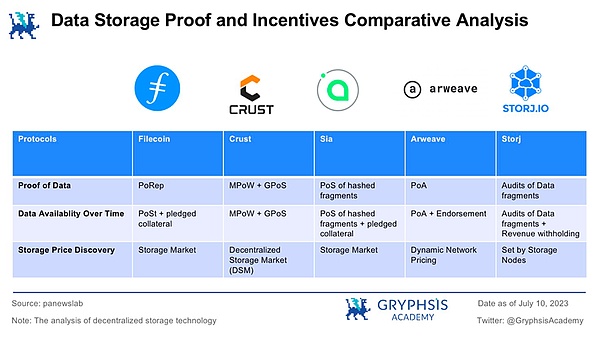
>
On FileCoin, before receiving any storage request, the storage miner must deposit the mortgage into the network as a promise to provide storage to the network.After completion, miners can provide storage in the storage market and pricing them.At the same time, Filecoin innovatively proposed POREP and POST for miners’ storage verification.
>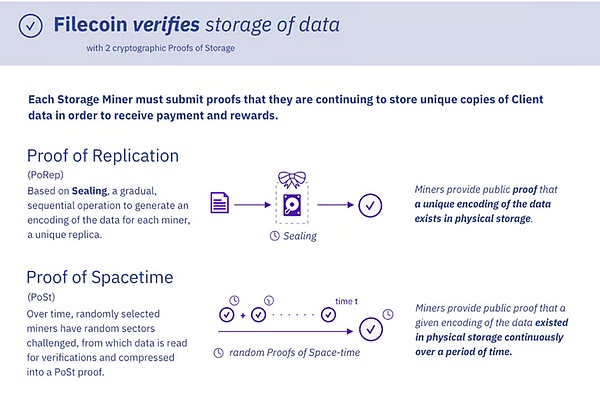
Source: Filecoin
Copy copy proof (POREP):Miners need to prove that they have stored unique copies of data.The unique encoding ensures that the two storage transactions of the same data cannot reuse the same disk space.
Time and Space Certificate (POST):During the life cycle of storage transactions, storage miners need to prove every 24 hours to prove that they continue to allocate dedicated storage space to store the data.
After submitting the certificate, the storage space provider will get the FIL return. If the promise cannot be obeyed, the mortgaged token will be confiscated.
However, over time, storage miners need to always prove that their ownership of the storage data is always proved by running the algorithm on a regular basis.However, a consistent inspection requires a lot of bandwidth.
And Filecoin’s novelty is that in order to prove the data to store and reduce the use of bandwidth over time, the output of the previous proof of the miners used as the input of the current proof, and the copy certificate was generated in order.This is performed by multiple iterations, which represent the duration of data to be stored.
>
Like Filecoin,The relationship between Crust and IPFS is also the relationship between the incentive layer and the storage layer.In Crust Network, nodes must also be stored in the collateral before receiving storage orders on the Internet.The amount of storage space provided by the node determines the maximum amount of mortgage. The mortgage is pledged and allows nodes to participate in the creation of a block on the Internet.This algorithm is called a guaranteed equity proof (GPOS), which guarantees that only nodes with equity on the Internet can provide storage space.
>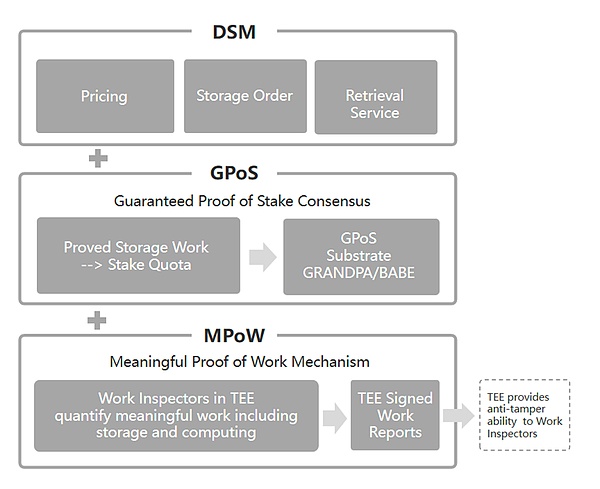
Source: Crust wiki
Unlike Filecoin, Crust’s storage price discovery mechanism depends on DSM,Nodes and users will automatically connect to the decentralized storage market (DSM), which will automatically choose to store user data on which nodes.The storage price is determined according to user demand (such as storage duration, storage space Storage Space, replication factor replication factor) and network factors (such as congestion Congestion).
When the user submits the storage order, the data will be sent to multiple nodes on the network. These nodes use the machine’s credible execution environment (Trusted Execution Environment) to split data and shake fragments.Because Tee is a closed hardware component, even if the hardware owner cannot be accessed, the node owner cannot rebuild the file by themselves.
After the file is stored on the node, the work report containing the file hash and the remaining storage of the node is published to the Crust blockchain.From here to ensure that the data is stored over time, the network regularly requests random data check: In Tee, the random Merkle Shh Hash and related file clips are retrieved. The fragment of this file is decrypted and scattered.Then compare the new dissipation with the expected scattered.The implementation of this storage certificate is called meaningful work proof (MPOW: Meaningful Proof of Work).
GPOS is a POS consensus algorithm that defines the quota by storing resources.Through the workload report provided by the first layer of MPOW mechanism, the storage workload of all nodes can be obtained on the Crust chain, and the GPOS algorithm of the second layer is to calculate a Staking quota for each node based on the workload of the node.According to this quota, POS consensus is performed.That is to say, the outlet reward is directly proportional to the mortgage volume of each node, and the upper limit of the mortgage of each node is limited by the node’s storage volume.
>
Compared with the previous two pricing models, Arweave uses very different pricing models. The core is that on Arweave, all stored data are permanent, and the storage price depends on the cost of 200 years of data storage on the Internet.
The bottom layer of the Arweave data network is based on Bockweave’s block generation mode.A typical blockchain, such as Bitcoin, is a single -chain structure, that is, each block will link to the first block in the chain.In the mesh structure of Blockweave, each block is also linked to the Random Block in the previous history of the blockchain.The memory block is determined by the hash value of the previous block in the block history and the height of the previous block. This is a certain way with a certainty but unpredictable way.When the miners want to dig or verify the new block, the miners need the right to access the information about the recovery block.
Arweave’s POA adopts the RandomX hash algorithm,The probability of lumps from miners = the probability of random recall block * The probability of finding hash was the first.Miners need to find a suitable hash value through the POW mechanism to generate new blocks, but Nounce relies on the previous block and any random memory block information.The randomness of the memory block makes miners encourage and store more blocks, thereby obtaining relatively high computing success rates and block rewards.POA also inspired miners to store “scarce blocks”, that is, the blocks that others have not stored to get greater probability and rewards.
>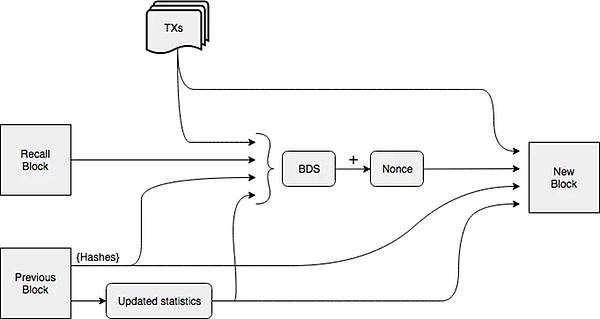
Source: Arweave Yellow Paper
When a one -time charging is the subsequent data reading as a free service, sustainable means that users can access the data at any time.So how do I have a long -term inspiration to provide data reading services with zero revenue?
>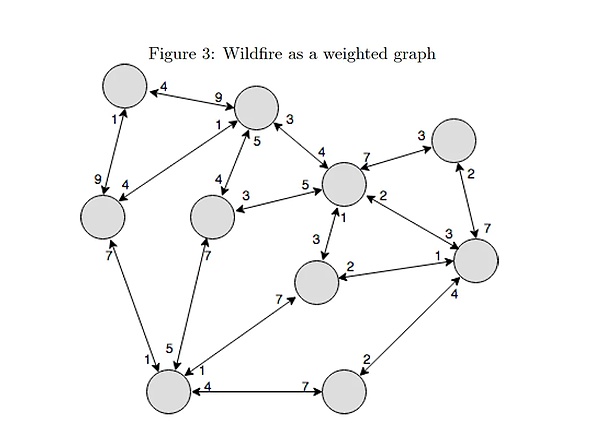
Source: Arweave Yellow Paper
In the design of BitTorrent’s game theory strategy “Optimistic Tit-For-Tat Algorithm”, the node is optimistic, and will be punished with other nodes.Based on this, Arweave designed Wildfire, a node scoring system with hidden incentive measures.
Each node in the Arweave network will score the adjacent nodes based on the amount of data and the speed of response. The node will give priority to selecting a high -ranking peer party to send requests.The higher the node ranking, the higher the credit degree, the greater the probability of the outlet, and the greater the possibility of obtaining scarce blocks.
Wildfire is actually a game, a highly scalable game.There is no “ranking” consensus between nodes, and there is no obligation to report the emergence and determination of the ranking, and the “good and evil” between nodes is adjusted by adaptive mechanism to determine the rewards and punishments that appear in new behaviors.
>
Like Filecoin and Crust, storage nodes must be stored in mortgages to provide storage services.On SIA, the node must decide how much mortgage: the mortgage directly affects the storage price of users, but at the same time, the release of low mortgage means that if they disappear from the Internet, the nodes have no loss.These forces push nodes to balanced collateral.
The user is connected to the storage node by the automatic storage market. Its function is similar to Filecoin: node setting the storage price, and the user sets the expected price based on the target price and expected storage time.Users and nodes will then automatically connect to each other.
>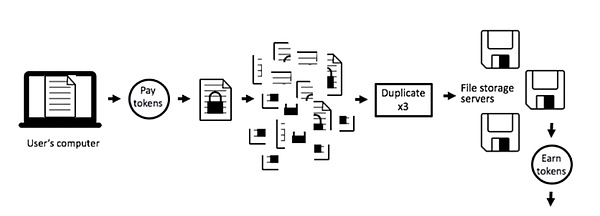
Source: Crypto Exchange
Among these projects, the SIA’s consensus agreement uses the simplest way: the storage contract is chained.After the user and the node reached an agreement on the storage contract, the funds were locked in the contract, and the screw code was used to divide the data into fragments. Each clip was used to use different encryption keys for separate scatters.Several different nodes.The storage contract recorded on the SIA blockchain records the terms of the agreement and the Merkle Tree Hash value of the data.
In order to ensure that the data is stored within the expected storage time, the storage certificate will be submitted to the network regularly.These storage proofs are created based on part of the random selected original storage file and the hash value list of the Merkle tree recorded on the blockchain.Each storage certificate submitted by the node will be rewarded for a period of time, and finally the reward is finally received when the contract is completed.
On the SIA, the storage contract can last for 90 days.To store files for more than 90 days, users must manually connect to the network with the SIA client software to extend the contract for another 90 days.Skynet is another layer above SIA. Similar to Filecoins Web3.storage or NFT.Storage platform, by allowing Skynet’s own client software instance to perform contract renewal for users to automatically complete this process for users.Although this is a way to change, it is not a SIA protocol level solution.
>
In the StorJ decentralized storage network, there is no blockchain or a structure similar to blockchain.No blockchain also means that the network has no consensus on the entire network.Instead, the tracking of the data storage position is processed by satellite nodes, and the data storage is processed by the storage node.Satellite nodes can determine which storage nodes are used to store data, and storage nodes can determine which satellite nodes receive storage requests from.
In addition to processing the data position tracking of cross -storage nodes, the satellite is also responsible for the storage and bandwidth use of the storage node and the billing and payment of bandwidth.Under this arrangement, the storage node sets its own price. As long as the user is willing to pay these prices, the satellites will connect them to each other.
>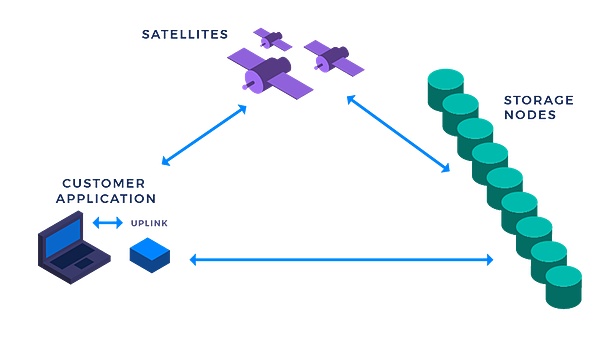
Source: Storj Github
When users want to store data on Storj, users must choose a satellite node to connect and share their specific storage requirements.Satellite nodes will then select storage nodes that meet the storage needs, and connect the storage node to the user.The user then transmits the file directly to the storage node and pays the satellite at the same time.Satellites then pay for the preserved files and bandwidth payment of the storage node for the saved files.
Such a technical solution is actually very centralized. The development of satellite nodes is completely defined by the project party.It also means that the project party has the pricing power.Although the centralized architecture also brings high performance services to Storj, as mentioned at the beginning, distributed storage does not necessarily equal decentralization.The ERC-20 token Storj released on Ethereum does not use any smart contract function, which only provides a variety of payment methods.
This has a lot to do with Storj’s business model. They focus on enterprise -level storage services, directly target Amazon’s S3 services, and establish a partnership with Microsoft Azure. It is hoped that providing enterprises with various performance indicators can be comparableBeyond Amazon stored services.In the case of unknown performance data, the cost of their storage is indeed much more cost -effective than Amazon. To a certain extent, it can be explained that the business model of decentralized storage can be available.
>
>
The choice of technical path also affects the design of the token model to a certain extent.Each of the four main decentralized storage network has its own economic model.
>
Filecoin, Crust, and SIA both use the tokens of Stake for Access (SFA).In this model, storage providers must lock the network assets of the network to accept storage transactions.The amount of locking is proportional to the amount of data that the storage provider can store.This is a situation. Storage providers must increase their mortgages when storing more data, thereby increasing the demand for online local assets.Theoretically, the price of assets should increase as the amount of data stored on the Internet increases.
Arweave uses a unique donation token model, which is added to the donation pool for a large part of each transaction.Over time, the tokens in the donation pool accumulate interest in the form of storage power.Over time, donations will be assigned to miners to ensure the durability of data on the network.This donation model effectively locks tokens for a long time: As the storage demand on Arweave increases, more tokens are removed from circulation.
Compared with the other three networks, Storj’s token model is the simplest.Its Token $ Storj is used as a payment method for online storage services, which is the case for end users and storage providers, as well as all other networks.Therefore, the price of $ Storj is a direct function for the demand for the $ Storj service.
>
It’s hard to say that a storage network is better than another.When designing decentralized storage networks, there is no single best solution.According to the purpose of the network and the problems they try to solve, we must weigh in terms of technical design, token economy, and community construction.
>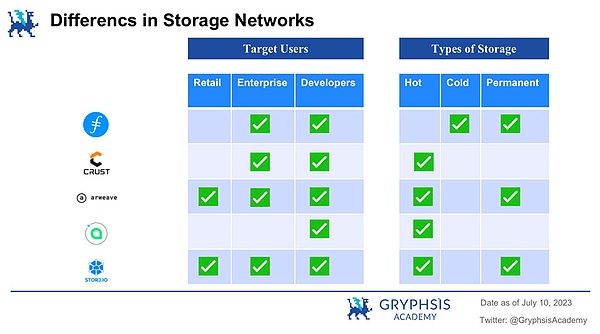
Filecoin is mainly for enterprises and applications to provide cold storage solutions.It has competitive prices and accessibility, making it an attractive alternative to the web2 entity for a large number of archive data to seek economic efficient storage.
Crust ensures excess redundant and fast retrieval, making it suitable for high -traffic DAPP and high -efficiency retrieval of popular NFT data.However, it lacks lasting redundancy, which seriously affects its ability to provide permanent storage.
Arweave stands out from other decentralized storage networks with its concept of permanent storage, which is particularly popular in storing Web3 data (such as blockchain status data and NFT).Other networks are mainly optimized for hot storage or cold storage.
SIA aimed at the hot storage market, mainly focused on seeking a complete decentralization and private storage solution for fast retrieval time.Although it currently lacks local AWS S3 compatibility, visiting layers like FileBase provide such services.
Storj seems more comprehensive, but sacrificed some decentralization.STORJ has significantly reduced the entry threshold for AWS users and caters to the key target audience of corporate hot storage optimization.It provides cloud storage compatible with Amazons3.
>
In terms of ecosystem construction, we can mainly discuss two types: the first category is that the upper -level DAPPS is completely established on the storage network, which aims to enhance the function and ecosystem of the network; secondly, the existing decentralized applications and protocols such as OpenseaAAVE et al. Selected with specific storage network integration to become more decentralized.
In this section, we will focus on FileCoin, Arweave and Crust, because SIA and Storj have no outstanding performance in the ecosystem.
>
>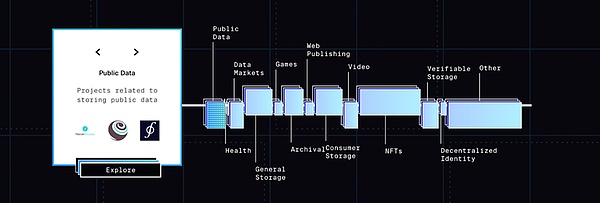
Source: Filecoin
In the ecosystem displayed by Filecoin, 115 projects have belonged to the first category of the above. These projects are completely based on the underlying structure of Filecoin.It can be observed that most projects are concentrated in general storage, NFT and consumer storage.Another important milestone in the Filecoin ecosystem is the Filecoin virtual machine (FVM), which is similar to the Ethereum virtual machine (EVM), which provides an environment required to deploy and execute code in smart contracts.
>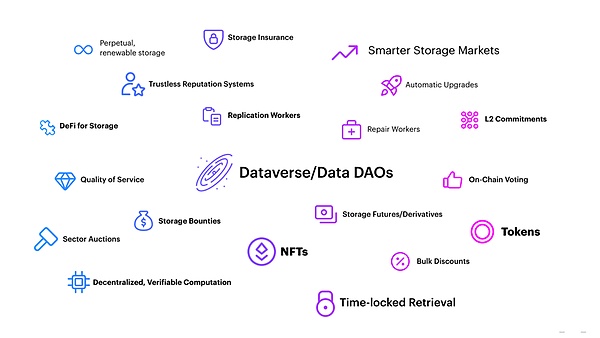
Source: Filecoin
With FVM, the Filecoin network has obtained the ability to execute smart contracts on the existing storage network.In the FVM, developers do not program the user’s storage data. Instead, they define how these data will automatically or have the conditions to operate automatically or conditionally after being stored in the network through smart contracts (to trust).The imagination of the scene is as follows:
-
Differential calculations based on data stored on Filecoin(Calculate at the storage location of the data, without the need to move it first)
-
Crowdfunding data set preservation plan-If anyone can fund storage some data that is very important to society, such as crime data or environmental warming related data
-
Intelligent storage market-If according to different time periods, copying levels, and available dynamic dynamic dynamic dynamic adjustments in a certain area)
-
Hundreds of years of storage and sustainable hosting-If the store data, so that all generations can still use it
-
Data DAO or Token-If the value of the data as a token and set up DAO to calculate the calculation of coordination and transaction above it
-
Local storage NFTS-The cooperation with the registered records of tracking NFT collaborative positioning NFT content
-
Time lock data retrieved-If the company’s record is public, unlock related data sets
-
Mortgage(If the destination loan is issued to the storage provider, such as accepting the FIL+transaction proposal from a specific user, or increase the capacity at the determined time window)
>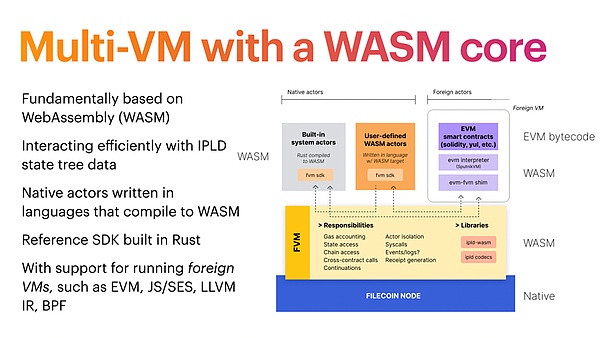
Source: Filecoin
At the same time, from the core point of view, the FVM virtual machine is based on Webassembly (WASM).This choice allows developers to write native upper -layer applications in any programming language that can be compiled as WASM.This feature makes Web3 developers easier to get started, because they can use the knowledge they have already mastered to bypass the learning curve related to specific languages.
Developers can also transplant the existing Ethereum smart contract, and only need to change the source code (even without) the source code.The ability of the Ethereum Network to be audited and tested in the Ethereum network enables developers to save development costs and time, and users can also enjoy practicality under the minimum risk.
>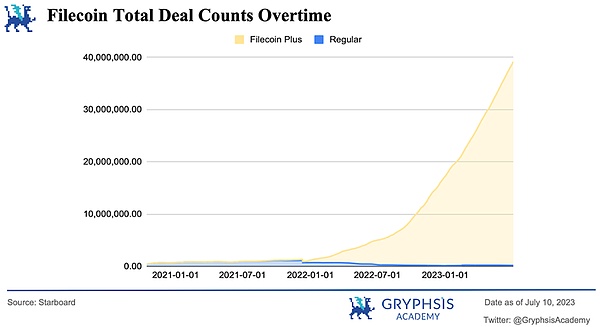
It is also worth mentioning Filecoin Plus, which is a program designed to subsidize users with large and valuable data sets with discounts.Customers who want to upload data to the Internet can apply for a group of members selected in the community. The notary of notarization reviews and distributes resources called DataCAps (data quotas) to the client.Customers can then use DataCap to subsidize their transactions with storage providers.
The Filecoin Plus program brings many benefits, making the Filecoin network more active, and the storage of valuable data continues to generate block demand; customers can get better services at a highly competitive price; as the increase in block rewards increases, it has increased, and it has increased.Compared with 2021, after the launch of Filecoin Plus in 2022, the stored data will increase 18 times.
>
Compared with Filecoin and Arweave, Crust has different paths in the construction of ecosystems.It is more inclined to cooperate and provide services directly with existing Web3 applications, rather than inspiring third -party developers to build their own ecosystem applications on Crust.The main reason is that Crust is built on Polkadot. Although Ethereum and COSMOS ecology are considered by the initial consideration of Crust project, they are not compatible with their technical paths.Crust prefers Polkadot’s Substrate framework to provide a customized development space, chain upgrade and chain governance.
>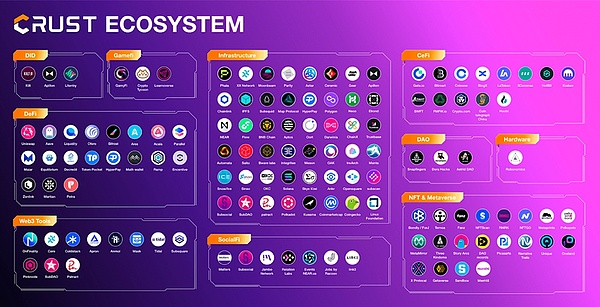
Source: Crust Network
Crust performed well in developers’ support.It introduces the Crust development toolkit, which includes JS SDK, Github Actions, Shell Scripts and IPFS SCAN to meet the integration preferences of different Web3 projects.At present, the development toolkit has been integrated into various web3 projects, such as Uniswap, AAVE, Polkadot Apps, Liquity, XX Messenger, and RMRK.
According to the data provided on the official website, more than 150 projects are currently integrated with the Crust Network.A large part of these applications (more than 34%) are DEFI projects.This is because the DEFI project usually has high performance requirements for data retrieval.
As mentioned earlier, on Crust Network, the data is copied to at least 20 nodes, and in many cases, it is copied to more than 100 nodes.Although this really requires a larger initial bandwidth, the ability to retrieve data from multiple nodes accelerates file retrieval and provides strong redundancy when faulty or nodes leave the network.Crust Network depends on this high -level redundant because it does not have a data supplement or repair mechanism like other chains.In these decentralized storage networks, Crust Network is the youngest.
>
>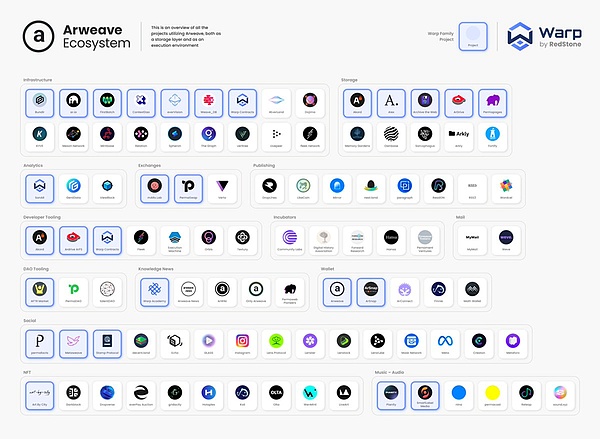
Source: Arweave, The Newest Ecosystem Landscape
As shown in the figure above, Arweave also has a powerful ecosystem.Among them, about 30 applications are marked, they are completely based on Arweave.Although there are not 115 applications of Filecoin, these applications still meet the basic needs of users, covering extensive fields, including infrastructure, exchanges, social and NFT, etc.
It is particularly noteworthy is a decentralized database based on Arweave.Arweave mainly uses its block organization for data storage, and is calculated outside the user -end execution chain.Therefore, the cost of using Arweave is only determined by the amount of data stored on the chain.
The separation of this calculation and chain is called a storage -based consensus paradigm (SCP), which solves the scalability challenge of the blockchain.SCP is feasible on Arweave. Because the data input is stored on the chain, the calculation of the chain will be trusted in the same state as the chain calculation.
The success of SCP opened the door for the development of many data libraries on Arweave.Four different databases built on Arweave:
>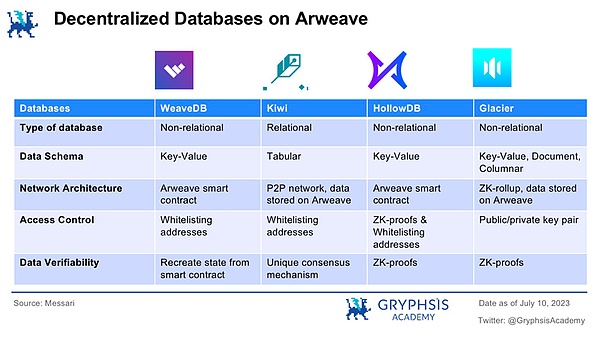
-
Weavedb:As a key -value database built on the smart contract on Arweave, it uses a white list address to access control logic.
-
Hollowdb:As a key -value database built by the smart contract on Arweave, it uses a white list address and ZK to ensure the verification of the data.ZK proof is also used to ensure the verification of data.
-
Kwil:A SQL database runs its own P2P node network, but uses Arweave as the storage layer.It uses the public key/private key to the access control logic and use its own consensus mechanism to verify.
-
Glacier:A NOSQL database with a architecture of ZK-Rollup and using Arweave as its data availability layer.It uses the public key/private key as a access control logic, and uses ZK to prove it as data verification.
>
The growth of decentralized storage depends on several core factors. According to its characteristics, these factors can be divided into three categories: overall market prospects, technology and public awareness.These factors are related to each other and complement each other, which can be further divided into more subtle subclasss.Subsequent paragraphs have subdivided each factors.
>
>
As the Internet penetrates into contemporary life, cloud storage services are almost essential for everyone.In 2022, the global cloud storage market reached an amazing $ 78.6 billion, and the growth trajectory did not show signs of weakening.A market research shows that by 2027, the industry’s valuation may reach US $ 183.75 billion.
At the same time, IDC predicts that by 2029, the valuation of the cloud storage market will reach $ 376 billion.IDC’s prediction further illustrates the growing demand for data storage. This forecast is expected to expand to 175 Zettaytes by 2025.In view of these hopeful prospects, it can be concluded that decentralized storage will be benefited from the overall market growth as a substitute for Web2 similar products, and it will promote it to rising orbit.
>
>
As one of the key infrastructure of Web3, the growth of decentralized storage has an inner connection with the expansion of the entire cryptocurrency market.Even without considering the surge in storage demand, if the adoption rate of digital assets continues to rise, the market size of decentralized storage may increase steadily.Without the infrastructure under power, the real decentralization cannot be achieved.The increase in the use of cryptocurrencies may have a more understanding of the importance of the public about decentralization, thereby promoting the use of decentralized storage.
>
>
The value of data is often reflected in the analysis significance it provided, which requires data calculation.However, in the existing decentralized storage market, the obvious lack of mature computing products is a major obstacle to large -scale data applications.Projects such as BACALHAU and Shale are responding to this challenge and focus on Filecoin.Other noticeable projects include FLUENCE and Space and Time, which are developing artificial intelligence query systems and computing markets.
With the vigorous development of computing products, the demand for computing resources will also increase.This demand can be slightly glimpsed through the price trajectory of $ RNDR. This is a peer -to -peer GPU computing network for users who need extra computing power.Its performance so far has increased its amazing 500%, reflecting the expectations of investors’ demand growth.With the maturity of these industries, the ecosystem becomes more comprehensive. With the influx of users, the use of decentralized storage will increase significantly.
>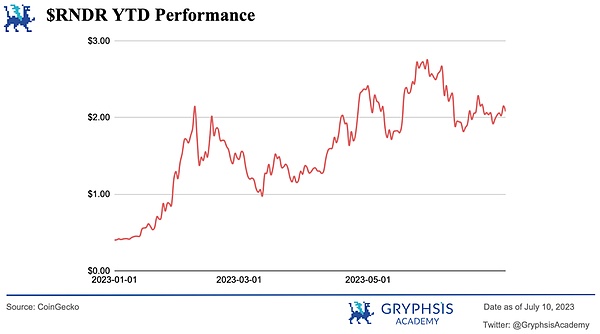
>
>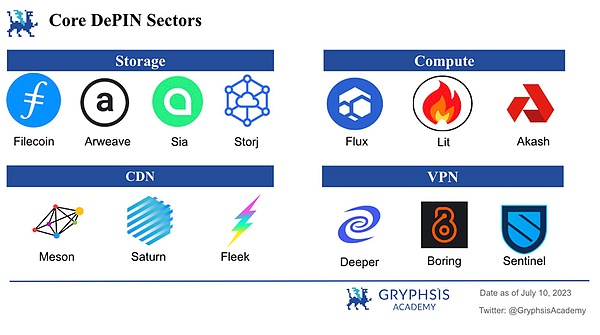
Decentralized physical infrastructure network (DEPIN) is a blockchain -based network that integrates digital infrastructure in the real world into the web3 ecosystem.The key areas of DEPIN include storage, computing, content delivery network (CDN) and virtual special network (VPN).These reforms are seeking efficiency and scalability by using encrypted economic incentives and blockchain technology.
>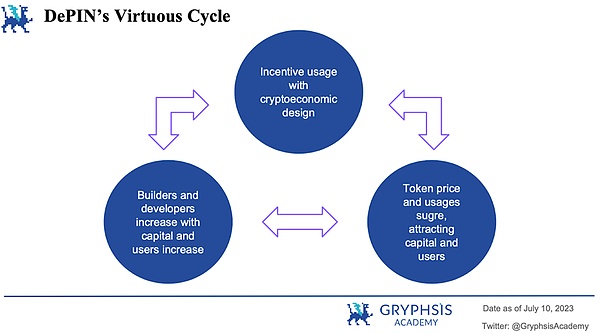
The advantage of DEPIN is that it has the potential to generate a virtuous cycle, including three important components.First of all, the agreement uses Token economic design to motivate participants, and usually enhances the actual application and network through Token.With the consolidation of the economic model, the soaring currency price and the rise of the agreement has quickly attracted people’s attention and promoted the influx of users and capital.This growing capital pool and expanding user base have attracted more ecological builders and developers to enter the industry, so that the cycle permanently.As the core track of DEPIN, storage will also become one of the main beneficiaries of DEPIN expansion.
>
The rapid development of artificial intelligence is expected to catalyze the growth of encrypted ecosystems and accelerate the development of various fields of digital assets.Artificial intelligence brings incentives from two main aspects to decentralized storage -the importance of stimulating storage demand and enhancing decentralized physical infrastructure networks (DEPIN).
As the number of products based on generation AI increased in index level, the data they generated also increased index levels.The surge in data has stimulated the demand for the storage solution, thereby promoting the growth of the decentralized storage market.
Although the Generative AI has increased significantly, it is expected that it will continue to maintain this momentum for a long time.According to EnterpriseAppStoday, by 2025, generating artificial intelligence will account for 10%of all the world’s generated data.In addition, the Cagr is expected to generate AI with a compound annual growth rate of 36.10%, and will reach US $ 188.62 billion by 2032, which shows its huge potential.
>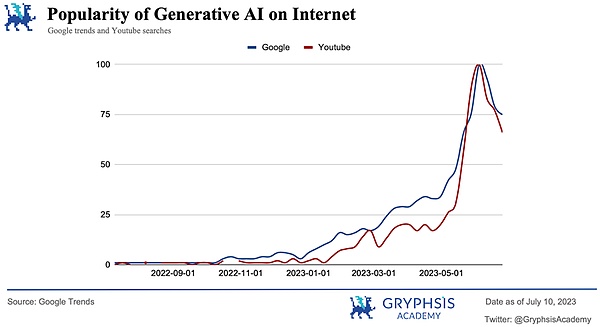
In the past year, the popularity of generating AI has increased significantly, and Google Trend and YouTube search have been evidence.This growth further highlights the positive impact of artificial intelligence on the demand for centralized storage solutions.
The surge in storage and computing resources required by artificial intelligence technology highlights the value of DEPIN.With the monopoly controlled by the web 2.0 infrastructure market by the central entity, DEPIN has become an attractive alternative solution for users who seek cost -effective infrastructure and services.By democratizing resources, DEPIN provides a significant and lower cost, thereby increasing the adoption rate.With the continued development of artificial intelligence, its demand will further stimulate the growth of DEPIN.Conversely, this helps decentralize the expansion of the storage industry.
>
Filecoin virtual machine (FVM) not only released the potential of Filecoin itself, but also completely changed the entire decentralized storage market.Because Filecoin is the largest decentralized storage provider, it occupies a large part of the market share, and its growth is basically parallel to the expansion of the entire industry.The emergence of FVM transformed Filecoin from a data storage network to a comprehensive decentralized data economy.In addition to achieving permanent storage, FVM also integrates DEFI into the ecosystem, so as to generate more income opportunities and attract greater user base and capital into the industry.
>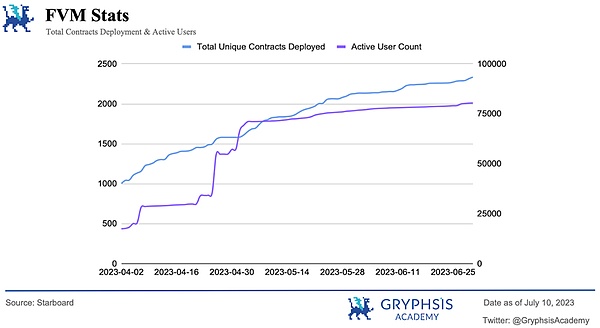
As of June 22, when the FVM launched for 100 days, more than 1,100 unique smart contracts that supported DAPP had been deployed on the Filecoin network.In addition, more than 80,000 wallets have been created, and the interaction with these FVM -driven DAPP has been started.The total balance of the FVM account and contract has exceeded 2.8 million FIL.
At present, the protocols in the FVM ecosystem are related to DEFI, which has enhanced the effectiveness of $ FIL.With the continuity of this upward trend, we are expected to have a large number of applications, which may cause another wave of growth in the storage market.
In addition, we also look forward to the introduction of FVM virtual machine mechanisms similar to FVM, which triggers ecological boom.For example, Crust Network officially launched its EVM storage on July 17, combining the Crust main network, Polkadot, and EVM contract to build a new Crust protocol to seamlessly provide storage services for any EVM public chain.
>
Both games and social applications require a decentralized database service, which can resist review and achieve high -speed reading and writing.The decentralized database can enhance the current web3 application and can support developing new applications and experiences in different fields.
-
Decentralization social-By storing a large amount of social data in a decentralized database, users will have greater control over their own data, can migrate between platforms and release the opportunity to monetize content.
-
game-In management and storage player data, game assets, user settings, and other game -related information are an important aspect of blockchain -based games.The decentralized database can ensure that these data can be seamlessly exchanged and combined by other applications and games.A popular topic in the field of Gamefi is the full -chain game, which means that all core modules, including static resource storage, game logic calculation and asset management, deployed to the blockchain.Decentralized databases with high -speed reading and writing functions are important infrastructure to realize this vision.
>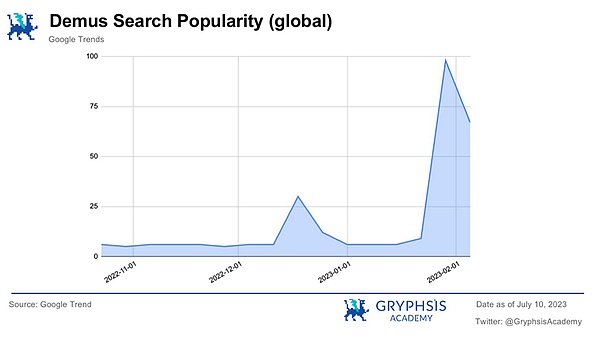
Games and social applications are the industry with the most Internet users and the industry that is most likely to produce killer applications, such as DEMUS that broke out in February this year.We believe that the outbreak of Web3 games and social applications will also bring huge demand for decentralized databases.
>
In addition to market prospects and technology, public consciousness is a key component to promote the growth of decentralized storage market.The centralized storage and decentralized storage clearly highlight the many advantages of the latter.
However, the ability to attract more users depends on more and more people aware of these benefits.This may be a long process that requires the joint efforts of the entire industry.
From content output to brand exposure marketing, industry practitioners must strive to convey how decentralized storage can completely change the field of cloud storage.This effort has supplemented other growth factors and enlarged the impact of market expansion and technological evolution.
>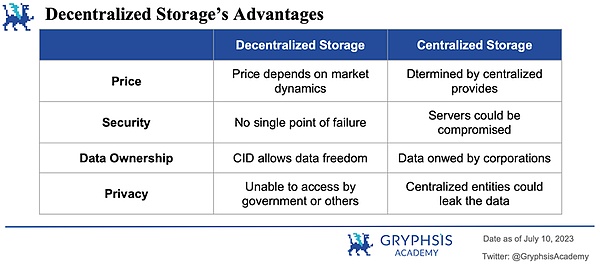
>
In general, decentralized storage is a huge infrastructure industry with a huge technology challenge. The investment cycle is long, but the growth potential is huge.
The long investment cycle is mainly due to the iterative cycle of distributed technology itself, and project developers need to find a delicate balance between decentralization and efficiency.Provide high -efficiency and high available data storage and retrieval services, while ensuring data privacy and ownership at the same time, it will undoubtedly explore extensive exploration.Even IPFS often experiences unstable access, and other projects like Storj are not decentralized.
The potential growth space of the market is also highly anticipated.In 2012, AWS S3 stored 1 trillion objects.Considering that an object may be between 10 and 100 MB, this means that only AWS S3 uses 100,000 to 100,000 PB storage space.
According to MESSARI data, as of the end of 2022, the largest provider Filecoin’s storage utilization rate was only about 3%.This means that only about 600 PB storage space on Filecoin is actively used.Obviously, there is still much room for development in the decentralized storage market.
With the rise of artificial intelligence DEPIN, we have maintained a bright prospect for the future of decentralized storage, because several key growth drivers will promote market expansion.
Reference information
[1] The Essential Guide to Decentralized Storage Networks
[2] Decentralized databases: The missing piece of web3
[3] Crust wiki
[4] Arweave: A Protocol for Economically Sustainable Information PerManence
[5] Blogs from Filecoin
[6] The most complete analysis of decentralized storage technology

